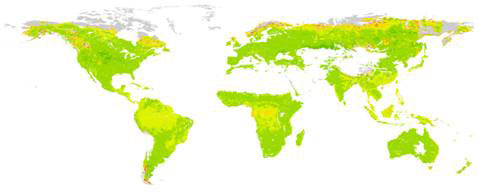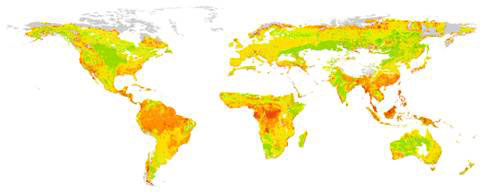| May 12, 2015 |
Biofuels: plant the right crop in the right place
|
|
(Nanowerk News) Corn, wheat and rapeseed can be used to produce biofuels, such as bioethanol and biodiesel. According to recent findings by environmental scientists at Radboud University, the location of the agricultural lands used to grow these biofuel crops has a major impact on the greenhouse gas emission they ultimately produce. The study that arrived at this conclusion is due to be published by Nature Climate Change ("Greenhouse-gas payback times for crop-based biofuels").
|
 |
| This figure shows the duration of the payback times for greenhouse gases produced by corn-based bioethanol per intensively farmed crop location, i.e. where fertilizers and irrigation are used. While intensive crop farming results in greater greenhouse gas emission, it also increases the yields of crops used to produce biofuels and, ultimately, reduces emission levels.
|
|
To increase production of biofuels from crops, such as corn and wheat, natural areas need to make way for agricultural land. The initial result of this is an increase in greenhouse gas emission. Using a global model, Pieter Elshout and fellow environmental scientists at Radboud University have demonstrated how long it takes for the advantages that biofuels offer over fossil fuels to earn a return on this initial emission. On the global scale, the average payback time for greenhouse gases is nineteen years.
|
 |
| This figure shows the duration of the payback times for greenhouse gases produced by corn-based bioethanol, per extensively farmed crop location, i.e. where fertilizers and irrigation are not used. While extensive crop farming reduces greenhouse gas emission, it also yields smaller crops for producing biofuels.
|
|
From Western Europe to the tropics
|
|
Elshout, a PhD candidate at Radboud University, explains: “Nineteen years sounds like a long time, but in farming terms, it’s not all that long. Furthermore, that figure is a global average. In Western Europe, that period is considerably shorter, sometimes spanning just a few years. In the tropics, however, it can extend past a hundred years.” The model demonstrates that the location of biofuel crops has a significant impact on greenhouse gas emission – more so than does the type of crop or crop management (i.e. the amount of fertilizers and irrigation used).
|
|
First global-scale model
|
|
“Our model,” Elshout continues, “is the first that offers a global, spatially-explicit overview of biogenic gas emission resulting from crops used to produce biofuels. In developing this model, our calculations of the durations of payback times took account of the entire production chain for fossil fuels and biofuels with the accompanying greenhouse emissions.” This global model is applicable to first-generation biofuels. These include bioethanol from corn, wheat and sugar cane, as well as biodiesel from soybeans and rapeseed.
|
|
Food for discussion
|
|
These results will contribute an angle of nuance to the current debate on biofuels in the Netherlands. In a follow-up study on biofuel crop farming, Elshout and his colleagues hope to investigate the payback times related to the impact on biodiversity.
|


